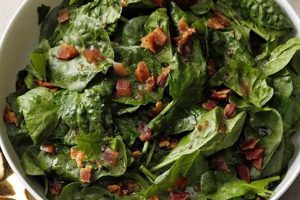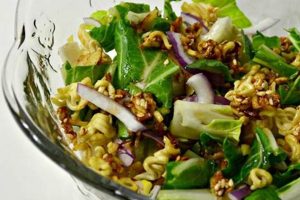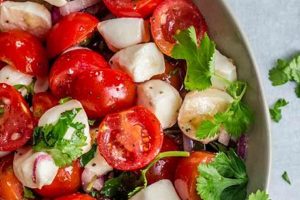A guide to creating a refreshing and flavorful cabbage salad typically involves a creamy dressing, often mayonnaise-based, and can include various additions such as shredded carrots, onions, and seasonings. Variations exist using vinegar-based dressings for a tangier flavor profile.
This versatile dish offers a simple way to incorporate fresh vegetables into one’s diet. Its adaptable nature allows for customization to suit various palates and dietary needs, from classic creamy versions to lighter, vinegar-based options. Historically, cabbage salads have been appreciated for their affordability and nutritional value, evolving from basic shredded cabbage with simple dressings to the diverse range of preparations available today.
This exploration will cover a variety of preparation methods, ingredient options, and serving suggestions to help readers create the perfect cabbage salad for any occasion.
Tips for Coleslaw Success
Achieving optimal flavor and texture requires attention to detail throughout the preparation process. The following tips provide guidance for creating a superior cabbage salad.
Tip 1: Cabbage Selection and Preparation: Opt for fresh, firm cabbage heads. Remove the core and finely slice or shred the cabbage for optimal texture. Soaking shredded cabbage in ice water for 30 minutes before dressing can enhance crispness.
Tip 2: Dressing Consistency: Balance creaminess and tang is key. Taste and adjust seasonings as needed, allowing the flavors to meld for at least 30 minutes before serving.
Tip 3: Ingredient Incorporation: Add shredded carrots, onions, or other desired vegetables for added flavor and nutritional value. Ensure even distribution throughout the mixture.
Tip 4: Seasoning Enhancement: Experiment with seasonings beyond basic salt and pepper. Consider celery seed, caraway seeds, or a pinch of red pepper flakes for depth of flavor.
Tip 5: Chilling and Serving: Chilling the salad for at least an hour before serving allows the flavors to meld and enhances the refreshing quality. Serve chilled as a side dish or incorporated into sandwiches and wraps.
Tip 6: Vinegar-Based Alternatives: For a lighter option, consider a vinegar-based dressing. Apple cider vinegar or white wine vinegar create a tangy, refreshing alternative to mayonnaise-based dressings.
Tip 7: Storage: Store leftover salad in an airtight container in the refrigerator for up to three days. Note that the texture may soften slightly over time.
By following these guidelines, one can consistently create a flavorful and satisfying cabbage salad suitable for a variety of occasions.
These tips provide a foundation for crafting a delicious and versatile dish. Experimentation and adaptation to individual preferences are encouraged.
1. Ingredients
Ingredient selection significantly impacts the final quality and character of a coleslaw. Careful consideration of each component contributes to the desired balance of flavor, texture, and visual appeal. The following facets highlight the crucial role ingredients play in a successful preparation.
- Cabbage:
The foundation of coleslaw, cabbage provides the dominant flavor and texture. Green cabbage offers a slightly peppery, crisp base, while red cabbage introduces a milder, sweeter flavor and vibrant color. Napa cabbage offers a delicate, sweeter alternative with a softer texture.
- Carrots:
Carrots contribute sweetness, color, and textural contrast. While commonly shredded, variations include grated or julienned carrots for a different visual and textural experience. Pre-shredded carrots offer convenience.
- Other Vegetables:
Incorporating additional vegetables expands flavor profiles and nutritional value. Red onion adds a pungent bite, while bell peppers introduce sweetness and color. Shredded jicama offers a crisp, refreshing element.
- Dressing:
The dressing binds the ingredients and imparts the dominant flavor profile. Mayonnaise-based dressings offer creaminess, while vinegar-based dressings provide tang. Flavor variations include buttermilk, sour cream, or yogurt bases, incorporating herbs, spices, and sweeteners.
The interplay of these ingredients determines the final character of the coleslaw, from classic creamy versions to lighter, tangier variations. Thoughtful ingredient selection ensures a balanced and flavorful final product. Matching ingredients to the desired flavor profile is key to a successful coleslaw experience.
2. Preparation
Proper preparation techniques are essential for achieving the desired texture, flavor, and overall quality in a coleslaw. From initial ingredient handling to final assembly, each step contributes significantly to the end result. The following facets highlight the crucial aspects of coleslaw preparation.
- Cabbage Handling:
Careful handling of cabbage ensures optimal texture and minimizes bruising. Removing the core and outer leaves before slicing or shredding prevents tough, fibrous pieces in the final salad. Consistent shredding or slicing creates uniformity, ensuring even dressing distribution and enhancing visual appeal. Techniques include using a sharp knife, mandoline slicer, or food processor for efficient and consistent results.
- Ingredient Combination:
Proper combination of ingredients ensures even flavor distribution and prevents clumping. Adding dressing gradually and tossing gently ensures each element is coated without over-dressing or damaging delicate ingredients. Incorporating ingredients in stages, starting with sturdier vegetables and finishing with more delicate ones, maintains texture and prevents sogginess.
- Chilling and Resting:
Chilling allows flavors to meld and enhances the refreshing quality of the coleslaw. After combining ingredients and dressing, chilling for at least 30 minutes, and preferably longer, allows the flavors to deepen and the cabbage to soften slightly without becoming soggy. This chilling period also enhances the crispness of the vegetables. The optimal chilling time depends on the specific recipe and desired outcome.
- Dressing Emulsification:
Creating a stable emulsion, particularly in mayonnaise-based dressings, ensures a creamy, cohesive texture and prevents separation. Whisking ingredients vigorously or using a blender or food processor creates a stable emulsion that evenly coats the salad ingredients. Proper emulsification also contributes to the overall flavor and mouthfeel of the coleslaw.
These preparatory steps contribute significantly to the final quality and enjoyment of coleslaw. Attention to detail in each stage, from initial ingredient handling to final chilling, ensures a balanced, flavorful, and texturally appealing salad. Mastery of these techniques allows for consistent and satisfying results, enhancing the overall dining experience.
3. Dressing
Dressing is the defining element of coleslaw, transforming shredded cabbage and other vegetables into a cohesive, flavorful salad. The dressing’s charactercreamy, tangy, sweet, or savorydictates the overall sensory experience. Exploring the nuances of coleslaw dressings reveals their crucial role in recipe development and enjoyment.
- Base Ingredients:
The foundation of the dressing establishes its fundamental character. Mayonnaise creates the classic creamy coleslaw, while vinegar provides a lighter, tangier profile. Buttermilk, sour cream, or yogurt offer alternative bases, each contributing unique textural and flavor nuances. The base ingredient interacts with other components, influencing the final balance and intensity of the dressing.
- Flavor Enhancers:
Flavor enhancers build upon the base, adding complexity and depth. Sweeteners like sugar, honey, or maple syrup balance acidity. Tangy elements such as lemon juice or apple cider vinegar provide brightness. Spices and herbs, including celery seed, mustard powder, dill, or chives, contribute distinct flavor profiles. The careful balance of these enhancers determines the overall taste experience.
- Texture and Consistency:
The dressing’s texture contributes significantly to the overall mouthfeel of the coleslaw. A smooth, emulsified dressing evenly coats the ingredients, while a chunkier dressing provides textural contrast. The viscosity of the dressing influences how it clings to the vegetables, impacting both flavor delivery and visual appeal. Achieving the desired consistency is crucial for a balanced and enjoyable salad.
- Balancing Flavors:
Balancing sweet, sour, salty, and savory elements within the dressing is paramount. Acidity from vinegar or citrus balances the richness of mayonnaise or sour cream. Sweetness tempers tanginess, while salt enhances overall flavor perception. Achieving harmony among these elements ensures a well-rounded and palatable dressing that complements the vegetables.
The interplay of these facets determines the final character of the coleslaw, elevating it from a simple combination of ingredients to a complex and satisfying dish. Understanding the role of each component in the dressing allows for informed recipe development and customization, ensuring a delicious and well-balanced coleslaw experience.
4. Texture
Texture plays a crucial role in the overall enjoyment of coleslaw. The interplay of crisp, tender, and creamy elements creates a dynamic sensory experience. A successful coleslaw balances these textures, offering a satisfying contrast that enhances palatability. Overly crisp cabbage can be perceived as harsh, while excessively soft cabbage lacks textural interest. The dressing also contributes to the textural profile, with creamier dressings providing a smooth counterpoint to the crisp vegetables. Achieving the desired textural balance requires careful consideration of ingredient selection, preparation techniques, and dressing consistency. For example, using a combination of green and red cabbage can introduce subtle textural variations. Soaking shredded cabbage in ice water maintains crispness, while allowing the salad to rest after dressing allows flavors to meld and the cabbage to soften slightly. Understanding the impact of these factors allows for manipulation of texture to achieve the desired outcome.
Several factors influence the final texture of coleslaw. Cabbage variety significantly impacts the initial texture, with denser varieties offering more resistance to softening. Cutting technique also plays a role; finely shredded cabbage offers a delicate texture, while coarser shreds provide more bite. Exposure to dressing and resting time affect the cabbage’s texture, leading to softening over time. The dressing’s viscosity and the presence of other ingredients, such as shredded carrots or chopped nuts, further contribute to the overall textural profile. For instance, a thicker, mayonnaise-based dressing clings more heavily to the cabbage, potentially leading to quicker softening, while a lighter vinaigrette allows the cabbage to retain its crispness for longer. Incorporating ingredients like shredded apples or raisins introduces contrasting textural elements. Practical application of this understanding enables predictable texture manipulation, resulting in a coleslaw tailored to specific preferences.
Manipulating texture is key to crafting a coleslaw that caters to specific preferences. Whether a crisp and crunchy salad or a softer, creamier version is desired, understanding the contributing factors allows for informed decision-making throughout the preparation process. Attention to detail, from selecting the appropriate cabbage variety to controlling chilling time and choosing a complementary dressing, ensures a consistently satisfying textural experience. Challenges such as preventing excessive softening can be addressed by employing techniques like ice water baths and careful timing. Ultimately, mastering the interplay of these elements ensures a coleslaw with a desirable texture that enhances overall enjoyment.
5. Flavor Balance
Flavor balance is paramount in a successful coleslaw recipe. It distinguishes a refreshing, well-rounded salad from one that is overly sweet, sour, or bland. This balance hinges on the interplay of key flavor components: sweetness, acidity, saltiness, and savory notes. A harmonious blend of these elements creates a complex and satisfying taste experience. The specific ratios of these components depend on the desired flavor profile, ranging from tangy and vibrant to creamy and mild. For example, a classic creamy coleslaw typically balances the richness of mayonnaise with a touch of sweetness from sugar and a tangy note from vinegar or lemon juice. A vinegar-based coleslaw, on the other hand, might emphasize the acidity of vinegar, balanced by a subtle sweetness and the savory notes of spices like celery seed or mustard powder. Understanding the interplay of these flavors enables informed adjustments to achieve the desired balance.
Achieving flavor balance in coleslaw requires careful consideration of ingredient selection and the proportions in which they are used. The type of cabbage, for instance, influences the baseline flavor. Green cabbage offers a slightly peppery note, while red cabbage lends a milder, sweeter taste. The choice of other vegetables, such as carrots, onions, or peppers, further contributes to the overall flavor profile. The dressing plays a crucial role in flavor balance, as it carries the primary sweet, sour, and savory elements. Adjusting the amount of sugar, vinegar, or spices in the dressing allows for fine-tuning the flavor profile to suit specific preferences. Additionally, tasting and adjusting throughout the preparation process ensures the final product achieves the desired balance. Challenges, such as an overly sweet or sour coleslaw, can be addressed by adding complementary flavors to counteract the imbalance. For instance, a touch of lemon juice can temper excessive sweetness, while a pinch of sugar can mellow out excessive acidity.
Mastering flavor balance in coleslaw preparation elevates the dish from simple to exceptional. It transforms a basic combination of ingredients into a dynamic and flavorful salad that complements a variety of meals. This understanding allows for recipe adaptation and personalized flavor profiles, accommodating individual preferences and dietary needs. The practical application of these principles leads to consistent and delicious results, enhancing the overall culinary experience. It ensures that each bite offers a harmonious blend of flavors, creating a truly satisfying coleslaw.
6. Serving Suggestions
Serving suggestions enhance the versatility of coleslaw, extending its role beyond a simple side dish. Thoughtful presentation and pairings elevate the overall dining experience, showcasing coleslaw’s adaptability and compatibility with diverse cuisines and occasions.
- Classic Side Dish:
Coleslaw serves as a refreshing counterpoint to rich or savory main courses. Its crisp texture and bright flavors provide a palate cleanser, complementing grilled meats, fried chicken, or barbecue. The creamy or tangy nature of the coleslaw offers a textural and flavorful contrast to heavier dishes.
- Sandwich and Wrap Component:
Incorporating coleslaw into sandwiches and wraps adds texture, flavor, and moisture. It provides a crunchy element and a burst of flavor, enhancing the overall sensory experience. The type of coleslaw can be tailored to the sandwich filling, with a creamy coleslaw complementing pulled pork or a vinegar-based coleslaw enhancing fish tacos.
- Topping for Salads and Bowls:
Coleslaw can be used as a topping for green salads or grain bowls, adding a layer of flavor and texture. It introduces a creamy or crunchy element, enriching the overall composition of the dish. The coleslaw’s flavor profile can be adapted to complement the other ingredients in the salad or bowl.
- Accompaniment to Global Cuisine:
Coleslaw’s adaptability extends to its compatibility with diverse cuisines. It complements Asian-inspired dishes, adding a refreshing crunch to stir-fries or noodle bowls. It can also be served alongside Latin American cuisine, offering a cooling contrast to spicy flavors. The coleslaw recipe can be adjusted to incorporate flavors specific to the cuisine, such as adding cilantro and lime juice for a Latin American twist.
These serving suggestions highlight coleslaw’s versatility, demonstrating its potential beyond a traditional side dish. Creative pairings and presentations transform coleslaw into a dynamic culinary component, enhancing a wide range of meals and occasions. Its adaptability allows for seamless integration into diverse culinary contexts, making it a valuable addition to any recipe repertoire.
7. Variations
Variations within coleslaw recipes demonstrate the dish’s adaptability and potential for personalized flavor profiles. Modifying core ingredients and dressings allows for diverse culinary experiences tailored to individual preferences and dietary restrictions. This flexibility extends beyond simple substitutions to incorporating globally-inspired flavors and unique textural elements. Such variations transform a traditional side dish into a customizable culinary canvas, reflecting individual creativity and dietary needs.
Ingredient substitutions offer a primary avenue for coleslaw variation. Replacing traditional green cabbage with red cabbage introduces a sweeter, milder flavor and a vibrant color. Substituting shredded carrots with broccoli slaw, grated jicama, or chopped bell peppers alters both texture and taste. These substitutions cater to specific flavor preferences and expand nutritional diversity within the dish. For example, a slaw featuring broccoli and red cabbage offers a higher vitamin C content compared to a traditional green cabbage slaw. Similarly, using a vinaigrette dressing in place of a mayonnaise-based dressing reduces fat content and caters to those seeking lighter options. Variations based on global cuisines, such as a kimchi-inspired slaw with gochujang and sesame oil or a Greek slaw with Kalamata olives and feta cheese, introduce unique flavor profiles.
Understanding the interplay of ingredients and dressings within coleslaw variations allows for informed recipe development and personalized culinary experiences. These variations demonstrate the dish’s inherent adaptability and potential to accommodate diverse palates and dietary requirements. Challenges such as maintaining textural integrity despite ingredient substitutions can be addressed through techniques like brief ice water baths or careful selection of dressing viscosity. Ultimately, exploring variations within coleslaw recipes expands culinary horizons and reinforces the dish’s enduring appeal.
Frequently Asked Questions
Addressing common inquiries regarding cabbage salad preparation clarifies techniques and best practices for optimal results.
Question 1: How can one prevent coleslaw from becoming watery?
Excess moisture can result from dressing the salad too far in advance or not properly salting the cabbage to draw out moisture before adding the dressing. Salting the shredded cabbage and allowing it to rest for approximately 30 minutes before rinsing and combining with other ingredients and dressing helps prevent a watery final product.
Question 2: What are the best cabbage varieties for coleslaw?
Green and red cabbage are common choices, each offering distinct flavor profiles and textural nuances. Green cabbage provides a slightly peppery flavor, while red cabbage offers a milder, sweeter taste and vibrant color. Napa cabbage, with its delicate texture and sweet flavor, presents a suitable alternative for a softer coleslaw. The choice depends on individual preferences and the desired flavor profile.
Question 3: Can alternative dressings be used besides mayonnaise-based options?
Vinegar-based dressings offer a lighter alternative to traditional mayonnaise-based dressings. Apple cider vinegar, white wine vinegar, or rice vinegar can be used as a base, combined with oil, sweeteners, and spices to create a tangy and refreshing dressing. These dressings cater to those seeking lower-fat options or a different flavor profile.
Question 4: How long can coleslaw be stored in the refrigerator?
Properly stored in an airtight container, coleslaw typically lasts for up to three days in the refrigerator. However, the texture may soften slightly over time due to the interaction between the dressing and the vegetables. It’s important to note that vinegar-based coleslaws tend to maintain their texture better than mayonnaise-based versions during storage.
Question 5: What are some creative additions to enhance coleslaw flavor and texture?
Incorporating ingredients such as shredded apples, raisins, chopped nuts, or dried cranberries adds textural complexity and flavor nuances to coleslaw. These additions enhance the overall sensory experience and offer nutritional benefits. For instance, adding shredded apples introduces a contrasting sweetness and crisp texture, while chopped walnuts provide a satisfying crunch and healthy fats.
Question 6: How can one ensure a balanced flavor profile in coleslaw?
Balancing the flavors within the dressing is key to a well-rounded coleslaw. The interplay of sweet, sour, salty, and savory elements determines the final flavor profile. Adjusting the amounts of sugar, vinegar, salt, and spices allows for customization to suit individual preferences. Tasting and adjusting throughout the preparation process is crucial for achieving the desired balance.
Understanding these aspects of preparation ensures consistent, flavorful, and texturally pleasing results.
This concludes the frequently asked questions section. The following section delves into specific coleslaw recipes, offering practical applications of these principles.
Recipe Coleslaw Salad
This exploration has provided a comprehensive overview of the essential elements contributing to a successful coleslaw preparation. From ingredient selection and preparation techniques to the nuances of dressing creation and flavor balancing, each facet plays a crucial role in the final outcome. The versatility of coleslaw, demonstrated through various serving suggestions and recipe variations, underscores its adaptability to diverse culinary contexts and personal preferences. The importance of texture and its impact on the overall sensory experience has been highlighted, along with practical tips for achieving the desired textural balance.
Ultimately, a well-executed coleslaw transcends its seemingly simple composition, offering a complex interplay of flavors and textures. Further exploration and experimentation with ingredients, dressings, and serving styles are encouraged, promising a continuous journey of culinary discovery within the realm of this adaptable and refreshing dish.






